What Will Power Snowmobiling’s Future?
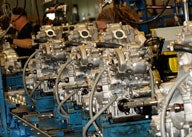
Envisioning new snowmobile engine technologies
Let the speculation begin. About this time every season we start to imagine what the 2014 snowmobiles will be like. Hey, we know what we’ve got for this year, but what about the future? And, in the case of certain manufacturers what should we expect under the hood?
Some interesting things are happening as we head into the future. We expect that the reign of fan-cooled two-strokes finally has come to an end, although their longevity has surprised us to date. They are not the most environmentally supportive engines. But they are relatively inexpensive and can power a host of small low-cost sleds. If they are gone, what do we have in their place?
After the Fan-Cooleds
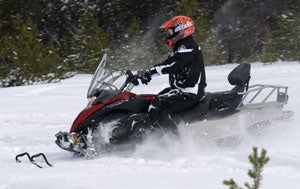 Yamaha committed to four-strokes years ago and seems to be set for power in the years ahead with a quad, a triple and twin.
Yamaha committed to four-strokes years ago and seems to be set for power in the years ahead with a quad, a triple and twin.Both Ski-Doo and Yamaha seem to have their post-fan-cooled engine world figured out. Yamaha can and is utilizing its 500cc twin cylinder four-stroke to power its Phazer-based models for sport and utility. There hasn’t been a two-stroke option at Yamaha for quite some time, so this company has moved on.
Ski-Doo added a nifty 600cc ACE four-stroke a few seasons back and has phased it into more and more models in recent seasons. Horsepower-wise it’s similar to the 550c fan-cooled that it is replacing. However, this newer Rotax four-stroker is much “greener” and offers far better mileage. Could there be a mini-turbo option to bring this 600’s power output up a step or two and let it replace the current two-stroke carbureted Rotax 600? Ski-Doo and its Rotax powerplants are moving forward, too.
Polaris Plans?
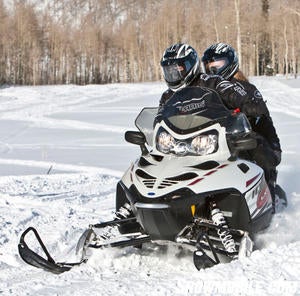 What does the future hold for Polaris’ fan-cooled, two-stroke, 550 twin?
What does the future hold for Polaris’ fan-cooled, two-stroke, 550 twin?
What about Polaris? It has a 750cc four-stroke that sat in some models, both normally aspirated and turbocharged. It also has a 550cc two-stroke twin that most certainly will not make the cut much longer. How clean can Polaris engineers make that motor? And why spend the money? With its capabilities and corporate internal connections, Polaris can create a new “budget” engine that is cleaner, more efficient and can be used to power low-end models currently getting propulsion from the long serving two-stroke.
Let’s not forget that Polaris owns or partners with European-based companies that build smallish utility engines useful as the basis for a new low-end four-stroke. Or, we expect that Polaris could create its own ACE-like twin. Or a single? Polaris has the expertise to engineer a 50 to 70 horsepower motor to replace the current two-stroke. It will be more complex, most likely heavier and probably more expensive to manufacture. But there is the option of outsourcing an engine from another engine maker. Fuji or Kawasaki among others comes to mind. But we do expect to see some alternative coming up. And we wouldn’t be surprised to see a clean burning one-liter four-stroke that allows Polaris to compete head-to-head with the Ski-Doo 1200 4-Tec and Yamaha Genesis touring/sport/utility engine category.
Cat’s fiscal 2015 and beyond
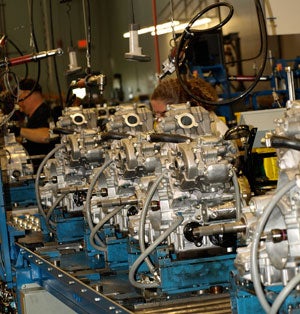 Arctic Cat ATV motors roll down the assembly line at the company’s St. Cloud facility that has already been designated as the location to produce a new series of Arctic Cat designed and built snowmobile engines.
Arctic Cat ATV motors roll down the assembly line at the company’s St. Cloud facility that has already been designated as the location to produce a new series of Arctic Cat designed and built snowmobile engines.That leaves Arctic Cat as the mystery. We don’t want to say that Cat spokesmen aren’t a bit smug, but they are tight-lipped for a company that already has announced that it will produce its own engines in fiscal year 2015 at its St. Cloud, Minnesota facility. We recently visited that plant to do an article for sister site, ATV.com. It’s quite amazing how efficient that assembly process is. But this is not an engine facility in the sense that new engines are designed, engineered, tested and assembled in it. No, Arctic Cat’s St. Cloud facility is one piece in the cog of engine development.
At this new-in-2007 plant Cat assembles ATV engines, primarily the current “H” series consisting of 500cc and larger displacement. The awesome 951cc V-twin comes from St. Cloud as does the fuel-injected 550 single. This plant assembles the motors from parts sourced across the globe. The logistics of getting these engines from naked cylinders, cranks and induction systems must keep some staff up nights. But it all comes together and the pieces find their way to one of two ATV engine assembly lines. One for the V-twin and another for single cylinder motors.
In a given time, more single cylinder motors can be assembled than the two cylinder versions. More parts, more complexity for the twin, which leads us to a convoluted sense of reasoning.
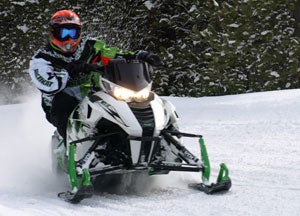 With the Suzuki-option out of the picture, what replaces Cat’s 177 horsepower one-liter turbo that gives the company’s sleds their performance boast?
With the Suzuki-option out of the picture, what replaces Cat’s 177 horsepower one-liter turbo that gives the company’s sleds their performance boast? We were informed during our visit that a third assembly line will be created in the (near?) future to accommodate snowmobile engines. Arctic Cat executives have already announced that this St. Cloud plant will add personnel and that, depending on demand, the plant may be expanded. Of course, that’s not a big deal really as the physical facility was designed from the very beginning to grow. The end wall was engineered to be taken off, moved further out and then reset to match up with the building sides that will be built out to make linear expansion. Currently the building consists of more than 55,000 square feet of production area, office space and an additional mezzanine space for anticipated offices and the like. With 15 acres available at the site, Arctic Cat can afford to grow for quite a while.
With room to grow and a professional and accomplished work force, Arctic Cat can develop engines to supply demand. At this point engineers in Thief River Falls work the computers to design and output sample engine pieces. Engine prototypes are tested in Thief, but manufacturing engineers representing the St. Cloud plant are involved to make certain that any new products can be assembled efficiently. You have quite a collaboration amongst engineers on such a project. St. Cloud is charged with producing the new engines and needs to keep its end as efficient as possible. That brings us back to the ATV line. One line is used to produce virtually all the single cylinder models. That suggests a commonality in the tooling to move the engines down the line. For example, a dimensionally similar bottom end can be affixed to the same assembly line mountings regardless of the different cylinders and heads.
Direct Injection
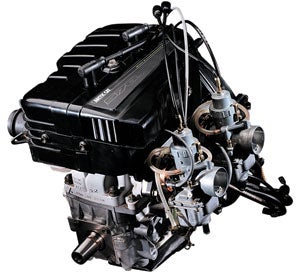 We expect that the fan-cooled 550 two-strokes like this Arctic Cat twin may finally exit the sport after hanging around far longer than we ever expected. Will Ski-Doo’s 600 ACE replace their 550 fan?
We expect that the fan-cooled 550 two-strokes like this Arctic Cat twin may finally exit the sport after hanging around far longer than we ever expected. Will Ski-Doo’s 600 ACE replace their 550 fan?So, that got us to thinking about future Arctic Cat engines. Currently Arctic Cat has a Suzuki-built 800cc two-stroke twin. The “600” trail sport/utility engine is actually Suzuki’s non-turbo one-liter four-stroke, but that engine’s going away as Suzuki has been dropped as the engine supplier in favor of in-house Cat designs. We suggest that Arctic Cat might well create its own all-new 800cc two-stroke and downsize its innards to make up at least one all-new 600cc twin. We could see a couple versions of a new 600 two-stroke: one for the trail performance set who likes the two-stroke’s light weight and a second that could be a detuned version to 80-hp or less that would replace the current fan-cooled two-stroke and give Cat a strong player in the cross country racing classes. Hey, even a downsized 500cc version could be in the cards and potentially easily assembled at Cat’s engine facility.
Since Arctic Cat is one of many companies tinkering with two-stroke direct injection technologies from sources such as Orbital and Mercury Marine, we surmise that the next Cat two-strokes may well be direct injected. Of course, having said that about Arctic Cat, we admit we have been waiting years for Polaris to take that step with its Cleanfire twins as well.
Keep in mind that this is all strictly conjecture, with no verification of any kind. With the success of the Rotax direct injection engines, we are envisioning the majority of next generation two-strokes being direct injected. There is still a market for the two-stroke, especially clean burning ones. After a visit to Arctic Cat’s ATV engine plant, we were struck by how easily that facility could add capacity to build two-strokes. A comment has been made that the snowmobile engines would have fewer pieces to assemble than the existing ATV four-strokes and more could be turned out per shift. Fewer pieces? Greater volume? That leads us to think of two-strokes. Pretty simple designs, we’d say.
Crystal Ball Fogs Up
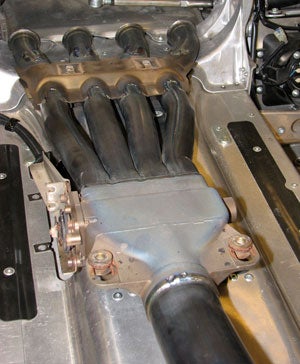 To get more performance from its top line Apex, Yamaha added new-to-snowmobile exhaust technologies like EXUP.
To get more performance from its top line Apex, Yamaha added new-to-snowmobile exhaust technologies like EXUP.Admittedly, we have trouble with our crystal ball when it comes to the biggest, most powerful engine Arctic Cat must have planned. After all, Arctic Cat prides itself on being the snow dudes with the most horsepower and highest top speed. You really don’t buy an Arctic Cat for cushy cruising comfort. You buy it for performance. That’s the statement of the XF1100 Turbo Sno Pro. We don’t see Arctic Cat backing off on that. Can they build an 800 or even a 900 two-stroke twin with enough muscle to retain the current claims? Add a blower for more power and consistent performance in the powder and total straight-line acceleration at sea level.
Our crystal ball fogs up when we look at Polaris as well. There are nice 800 and 600 two-stroke twins, but are they clean enough? Powerful enough? And what is happening on the four-stroke front? Will Ski-Doo boost its 1200 4-Tec or the 600 ACE? And if Yamaha offers a limited amount of turbos and superchargers for powder and flat land play, what does that really mean?
Looking at all the sled makers, we see each brand with three basic motors: a top line high performance “muscle” engine of at least 800cc; a solid 600 category motor for flatland rough riders and solo touring applications; and a utility type 50 to 70 horsepower engine that can be used in the lower cost models for two-up touring, utility, entry
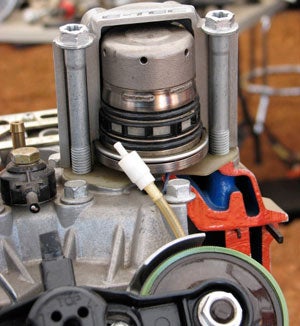 Equipped with sophisticated direct injection, Rotax-built E-Tec powerplants give Ski-Doo potent and lightweight trail sleds that also run “green”.
Equipped with sophisticated direct injection, Rotax-built E-Tec powerplants give Ski-Doo potent and lightweight trail sleds that also run “green”.level sport and fleet sales. Up to this point all three sled makers come to the party loaded with similar engine output. Arctic Cat is the current wildcard as its sets off in its own in-house direction. We expect a successful one as its series of hemi-headed H-series ATV engines can attest. They are brawny, powerful and help Cat retain its role as the power kid on the dirt.
It’s amazing how an afternoon visit to Arctic Cat’s engine facility in central Minnesota can get the mind to conjecturing weird thoughts. We don’t expect Arctic Cat to come into the 2014 model year with all of its bullets, but it will have to start chambering some rounds pretty soon and we suspect that the St. Cloud plant will be a key link to its armory of power. We’re betting on a high-tech, direct injection two-stroke that can transition from an 800 to a 600 or even a 500. We also suspect that we haven’t seen the last of the blowers either. It was Arctic Cat that brought us the T660 high-boost triple and then came with a more moderate boost in the Suzuki-built one-liter twin. Cat likes performance. Cat buyers demand it. Cat will supply it. That’s who they are in Thief River Falls – and St. Cloud. Now let’s see if we got any of this right or if maybe we should change a prescription or two.
Related Reading The “Spirit” of the Arctic Cat/Suzuki Partnership The State of the Sport is Doing Well What is Snowmobiling’s Next Big Thing?



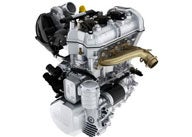
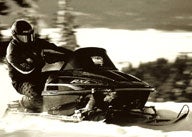
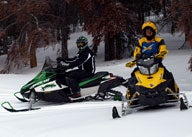


 Your Privacy Choices
Your Privacy Choices